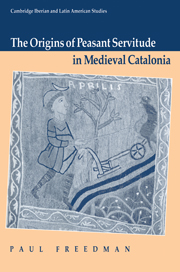Book contents
- Frontmatter
- Contents
- List of tables
- Preface
- List of abbreviations
- Map 1 Densities of Remença households at the end of the Civil War
- Map 2 Catalan comarcas and principal towns
- Map 3 Pyrenees and pre-Pyrenees
- 1 Introduction: medieval serfdom and Catalonia
- 2 Enduring characteristics of rural Catalonia
- 3 The free peasants of the ninth to eleventh centuries
- 4 Changes in the status of peasants: late twelfth and early thirteenth centuries
- 5 Catalan servitude in the thirteenth century
- 6 Effects of the Black Death
- 7 Peasant agitation and civil war, 1388–1486
- Conclusion: origins of Catalan servitude
- Appendix 1
- Appendix 2
- Appendix 3
- Appendix 4
- Bibliography
- Index
2 - Enduring characteristics of rural Catalonia
Published online by Cambridge University Press: 06 January 2010
- Frontmatter
- Contents
- List of tables
- Preface
- List of abbreviations
- Map 1 Densities of Remença households at the end of the Civil War
- Map 2 Catalan comarcas and principal towns
- Map 3 Pyrenees and pre-Pyrenees
- 1 Introduction: medieval serfdom and Catalonia
- 2 Enduring characteristics of rural Catalonia
- 3 The free peasants of the ninth to eleventh centuries
- 4 Changes in the status of peasants: late twelfth and early thirteenth centuries
- 5 Catalan servitude in the thirteenth century
- 6 Effects of the Black Death
- 7 Peasant agitation and civil war, 1388–1486
- Conclusion: origins of Catalan servitude
- Appendix 1
- Appendix 2
- Appendix 3
- Appendix 4
- Bibliography
- Index
Summary
C.J. Wickham, describing the mountains of Italy and their surprising variety of tenurial systems, finds two extremes of tenurial arrangements, one free and the other oppressive. Mountainous terrain encouraged on the one hand the impoverished freedom associated with such diverse highland communities as the Swiss cantons, the Appalachian region of the United States, or the mountainous parts of the Mediterranean shore. At the other pole is the brutal and arbitrary lordship (“the Count Dracula model”), also characteristic of highland communities, made possible by the limitations of central authority whose powers, while extensive at sea-level, tended to dissipate at higher altitudes, affording considerable possibilities to local tyrants. The two extremes coexisted in medieval Catalonia. Not only did each valley have a unique character but, more basically, peasants in Old Catalonia tended to be both hereditary proprietors and (increasingly as time went on), serfs. Oppression and autonomy existed side-by-side.
A dispersed habitat
In the period of its formation, during the ninth and tenth centuries, Catalonia was settled by free peasants who established very small villages or isolated farmsteads. Catalonia during this time was a frontier society, providing at least the possibility of favorable conditions for peasant life. It is important to emphasize, however, that the existence of a frontier did not in itself guarantee free status or compact individual properties. One finds tenurial patterns similar to those of Catalonia in Languedoc, although it lay well behind the borders with Islam.
- Type
- Chapter
- Information
- The Origins of Peasant Servitude in Medieval Catalonia , pp. 26 - 55Publisher: Cambridge University PressPrint publication year: 1991

